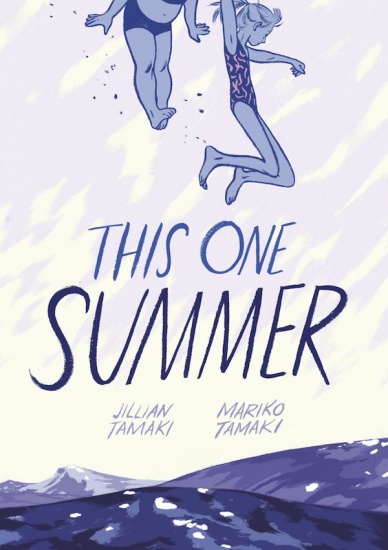
Last week, Jillian and Mariko Tamaki’s “This One Summer” earned a very rare honor. In fact, the honor they earned – the Caldecott, given to the most distinguished children’s picture books of the year – marked the first time a graphic novel ever earned the distinction. If that was it, that’d be a huge deal, but they were also given a Printz honor, which is given to the best books written for teens, giving them a huge year all in one day.
The awards are well deserved, as the pair crafted a story that’s a beautiful, emotional tale of growing up and the complications that come with that, amongst other things. The pair had previously earned significant esteem for their graphic novel “Skim”, but this one may have earned even more love, even becoming one of the most highly lauded releases in the comics internet’s 2014 end of the year rankings.
To celebrate those achievements, I spoke with Jillian and Mariko about the book, the excitement associated with earning those honors, what it means to be specifically cited by librarians, and more. Take a look below, as well as a look inside the book in case you missed it.
When I was a kid who was a voracious reader, the Caldecott was something I paid close attention to, and I wasn’t the only one. It’s long been a mark of true excellence, as has the Printz in recent years. What does earning those honors – as well as being the first graphic novel to earn the Caldecott – mean to you?
JT: It’s a fine balance. Recognition is a great thing but it can’t change the way you go about things. I try to think of it as a really fancy kind of encouragement that I’m on the right track. It means graphic novels continue to reach out to new audiences and, hopefully, are moving beyond novelty.
These awards come from the American Library Association, and they’re voted on my librarians around the nation. Librarians are some of the biggest evangelists for graphic novels around. How has the response been to your book from librarians been generally, and do honors from them have any special meaning to you as storytellers?
JT: Wonderful! When we were promoting SKIM in 2008, graphic novels were just starting to be embraced in a big way. Librarians have always had our backs. I think that the graphic novel form appeals to a lot of people, particularly children and teenagers, and librarians are into whatever encourages reading and engagement.
Yes, recognition from librarians is significant because it implies that they are seeing the work resonate with readers. That’s important to me; I don’t want it to just be a beautiful book. I want people to read and connect with it. Plus, I mean, librarians read a lot of books so they are very informed. Ha.

I’m a 31 year old guy from Alaska, but Rose’s story is something that I find very easy to connect with. There’s a real universality to both the story you tell, and to that time in anyone’s life regardless of gender. What is it that you think makes that time such a fertile ground for exploration for the two of you?
JT: Emotions are vivid, you’re starting to see nuance in the world. You’re having thoughts you think are pretty mind-blowing (even though, it turns out, they’re pretty universal).
Having Rose and Windy as the leads led to an interesting juxtaposition within the book, as Rose is right in that time of your life where everything just seems to get much more complicated, while Windy’s still pretty carefree and all about the simple pleasures in life. When you were developing the book, was there a specific reason to have the two leads be slightly different ages?
JT: That’s Mariko’s decision. I liked playing off the discrepancy though. I like the small gestures and body language. Windy is open. Rose can be more closed, crouched.

This One Summer focuses on the most awkward part of anyone’s life, and delivers a fun, heartfelt and honest look at the confusion that surrounds it. When you’ve spoken with readers of the book, of all ages but mostly younger girls, what has the response been like?
Continued belowMT: Very diverse. I’ve heard from readers of just about all ages at this point. It feels like everyone finds their own story and focus in reading this book.
It’s a beautiful book, but I’m curious Jillian, what drove the decision for the whole book to be depicted in that soft blue/purple ink? I love it, but I’m always interested in what was behind artistic decisions like that.
JT: It has a slightly melancholic, nostalgic feel without being overly so?
Mostly I thought it’d look cool.



